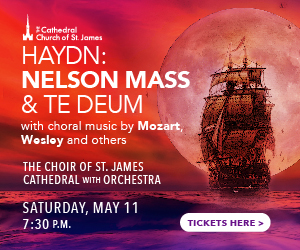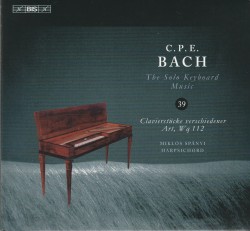
CPE Bach – The Solo Keyboard Music Vol.39
Miklós Spányi
BIS BIS-2370 (naxosdirect.com)
Verschiedener (varied) is perhaps an understatement for the sheer variety of compositions on this CD. The 22 movements break down into forms as intense and individual as Fantasias lasting less than two minutes and as structured as a 23-minute conventional three-movement Concerto. Miklós Spányi has thus set himself a challenge. In fact, regardless of the type of movement, throughout the whole of this CD he has to draw on the tremendous expertise normally required for compositions by the (i.e. JS) Bach. The aforementioned Concerto in its Allegretto and Allegro movements bear this out.
As if the compositions themselves were not sufficiently testing, Spányi discusses at great length the problems posed by the harpsichords of the day. There was a trend at the court of CPE Bach’s employer (Frederick the Great), to commission harpsichords from one highly fashionable centre, London. These instruments often incorporated specialized attachments not usually found on other harpsichords, something reflected in CPE Bach’s work – and adding to Spányi’s task.
While it is difficult to single out the most attractive tracks on this highly varied and attractive CD, the measured Allegro ma non troppo from the Sonata in D Minor is highly enjoyable, as are the demandingSinfonia in G Major and Fugue in G Minor.
Spányi has taken on so much to bring us this particular demonstration of CPE Bach’s skills and ingenuity. His interpretations deserve a wide audience.
Michael Schwartz
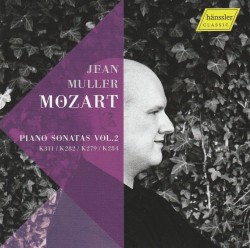
Mozart – Piano Sonatas Vol.2
Jean Muller
Hänssler Classics HC19074 (naxosdirect.com)
In a 21st-century sonic sea, awash with dozens of recordings of Mozart sonatas released each year, the savvy listener must scrutinize attributes from one such disc over another, divining the hallmarks of Mozartian keyboard perfection simply via one’s own tastes. In the case of Luxembourgian pianist Jean Muller’s newest release on the Hänssler Classic label, the listening experience is immediately amicable: we deeply appreciate Muller’s gifts at delivering this repertoire with expertise and humbled reverence.
Opening with Mozart’s inspired D Major Sonata, K311 – written in Mannheim in December 1777 – this record gently sets two oft-played works against two more heard infrequently; this programming is subtle and perfectly balanced. As bookends to the disc, the two sonatas in D stand as points of departure and return, closing with the earlier work of the two, K284, sometimes nicknamed the “Dürnitz” Sonata. (It was written in 1775 for a Baron von Dürnitz – a bassoonist – who infamously withheld payment for the sonata!). Incidentally, it is the longest of Mozart’s 19 solo piano sonatas.
Muller brings utter neoclassical eloquence to all four sonatas on the album, charming with cajoling melodies and playful ornamentation. The imaginative – even boyish – spirit of Mozart’s keyboard is fully on display here. Every interpretive decision Muller makes is of the highest order, historically informed and beautiful to behold. He has produced an engaging, aesthetically satisfying album, sure to make any savvy Mozart listener smile with delight.
Adam Sherkin
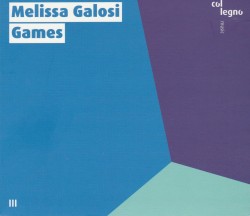
Games
Melissa Galosi
Col legno CL3 1CD 15001 (naxosdirect.com)
Italian pianist Melissa Galosi makes a strong case for the common wellsprings of both play and music on her debut album Games. She presents an argument for her thesis in piano music by master European composers of the 18th (W. A. Mozart) and 20th (György Kurtág) centuries. Kurtág rediscovered his compositional creativity in the 1970s through his observations of “…children who were spontaneously playing an instrument … who still saw the piano simply as a toy. They try to touch it, to caress it; they attack it and let their fingers run along the keyboard […] pure pleasure in the act of playing, joy of daring…” These experiences inspired his Játékok (“Games” in Hungarian), a substantial collection of piano works imbued with the creativity and wit of youthful games.
On the other hand Mozart never had a true childhood. Driven by his musician father, by the age of three he was hard at work practising the piano. His father kept him constantly practising, performing and touring: the very model of the prototypical child prodigy. Yet W.A. maintained a childlike sense of play for his entire life.
Galosi has chosen 17 aphoristic works from Játékok, interspersed with excerpts from three works by Mozart: variations on the famous Ah vous dirai-je maman (“Twinkle, Twinkle…”) and two other variation suites. I found the “mixed tape” across two centuries that Galosi presents convincing, musically delightful. Her playing is direct, unaffected, yet energetic and incisive when the music calls for it.
Andrew Timar
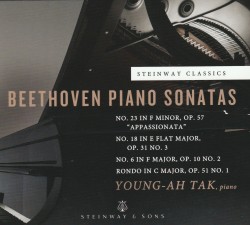
Beethoven Piano Sonatas Nos. 23; 18; 6
Young-Ah Tak
Steinway & Sons 30106 (steinway.com)
With his 250th birthday approaching, the popularity of Ludwig van Beethoven continues unabated for classical music audiences and performers alike. Captured here in her debut recording for the Steinway label, South Korean-born, now America-residing pianist, educator (on the faculty at SUNY Potsdam’s Crane School of Music) and academic, Young-Ah Tak, performs the late composer’s piano sonatas with a deft touch, a stylistically appropriate grand Romantic gesture and a level of familiarity with LvB’s work that is unsurprising, given the fact that her first solo recital, at age nine no less, included some of the very pieces captured here.
Recorded live at New York City’s Steinway Hall, this CD has an appropriately intimate quality to it and, as such, the engaged listener can identify, and, perhaps, even relate to the artistic struggle that occurs when an ambitious and deservedly feted pianist takes on a repertoire of well-trodden (and perhaps overly familiar) material – think Sonata No.23 in F Minor, “Appassionata” – yet desires to reify the expectations of an audience who demand that she make this material her own. Not an easy task, to be sure, but in Tak’s capable hands, new and effervescent subtleties of this music are introduced, exposed and played with to the satisfaction of both the performer and audience (and one would hope composer too). Nowhere is this more evident than in Tak’s dramatic interpretation of the clarion call “The Hunt,” (Piano Sonata No.18 in E-flat Major, Op.31, No.3). A recommended addition for piano enthusiasts and LvB collectors alike.
Andrew Scott
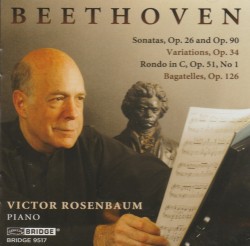
Beethoven – Sonatas Opp.26 & 90
Victor Rosenbaum
Bridge Records 9517 (bridgerecords.com)
Victor Rosenbaum’s third recording for Bridge Records underlines his affinity for classical-era composers. Here we have a selection of Beethoven’s piano pieces ranging from early to late works and including two sonatas, variations, rondo and bagatelles. The chronological progression of pieces on this album is a wonderful treatise on the evolution of Beethoven’s compositional style and techniques.
It is especially enjoyable listening to the two sonatas on this album. Sonata in A-flat Major Op.26 is charming and unconventionally structured, opening with a relatively slow movement in the form of a theme with variations. Rosenbaum is delightfully playful in the Scherzo and introspective in his interpretation of the striking Funeral March (third movement). Written some 14 years later, Sonata in E Major Op.90 contains only two movements but they are vastly different in character. The first movement, written in E Minor, is dramatic, depicting the loneliness and anguish that will later become even more prominent in Beethoven’s music. The second movement, written in E Major is, in contrast, gentle and more Romantic in character. Rosenbaum navigates between the two worlds so naturally; his interpretation is powerful in the first movement and exquisitely nuanced in the second.
The naturalness and the candour of Beethoven’s language is very much suited to Rosenbaum, who has no difficulty communicating his musical ideas with conviction. It is as if the acumen acquired in his long performing career has been poured into every phrase, thus making this recording special.
Ivana Popovic
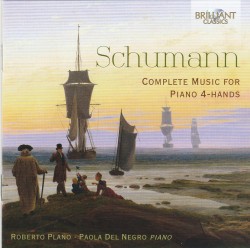
Schumann – Complete Music for Piano 4-Hands
Roberto Plano; Paola Del Negro
Brilliant Classics 95675 (naxosdirect.com)
There is something deeply satisfying about playing piano duets. Perhaps it is the synergy one might feel with his fellow player or the shared delight in casual music making. The jubilant sense of teamwork is undeniable in this recording. Pianists Roberto Plano and Paola Del Negro are an unyielding force together, beautifully attuned to each other’s ideas and expressions, and clearly ardent about Schumann’s music. Here we hear it all: passion, precision, style, energy and, above all, joy.
Schumann himself loved playing piano duets and wrote an extensive collection of pieces that ranged from his beginning years as a composer to the late Op.130. This 2CD album includes the whole scope of his piano four-hands music: eight early Polonaises (homage to Schubert); 12 Vierhändige Klavierstücke fur Kleine and große Kinder (which became well-known and loved pieces of the piano repertoire); Bilder aus Osten (influenced by Eastern poetry and philosophy); and two late collections of dance pieces, Ballszenen and Kinderball.
Some of these compositions are quite complex and many became quite popular, inspiring various arrangements. Here they are played with a combination of gusto and lyricism and an evident sense of style. With this album Plano and Del Negro pay tribute to all the intricacies and wonders of Schumann’s piano music while bringing forward their own artistic perspectives.
Ivana Popovic
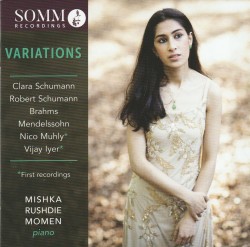
Variations
Mishka Rushdie Momen
Somm Recordings SOMMCD 0603 (somm-recordings.com)
The bright, young pianist Mishka Rushdie Momen has released a new recording that features works in variation form by assorted composers: Clara Wieck and Robert Schumann, Brahms, Mendelssohn, Nico Muhly and Vijay Iyer. Rushdie Momen’s thoughtful liner notes offer a rationale for her recording choices, explaining the “variation” thread that connects each piece on the disc. In some cases, there are direct quotes and reorganization of materials from an older piece to a newer one (Vijay Iyer’s Hallucination Party, After R. Schumann’s Op.99 is one such example). In other instances, works are referenced by thematic origin: Robert Schumann wrote variations on a theme by Clara and vice-versa; Brahms wrote variations on a theme by Robert Schumann, and so on.
Throughout the disc, one is struck by Rushdie Momen’s tonal command and wide-ranging technique as she wields the instrument in a quest for beauty of sound. This is a rare phenomenon today, particularly from a performer so young. Warmth and perfection of pianism seem at the forefront of Rushdie Momen’s musicianship; her attention to detail and technical confidence is on par with the artistry of such old master pianists as Clara Haskil, Sviatoslav Richter and Myra Hess.
Rushdie Momen can evidently manage any musical era with aplomb and the premiere recordings of works by Muhy and Iyer offer promise of exciting things yet to come from this gifted young artist. Composers – along with the rest of us – should flock to her keyboard side!
Adam Sherkin
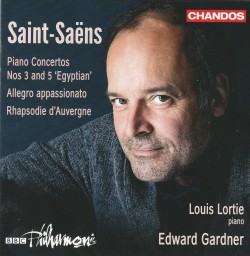
Saint-Saëns – Piano Concertos 3 & 5
Louis Lortie; BBC Philharmonic; Edward Gardner
Chandos CHAN 20028 (naxosdirect.com)
Camille Saint-Saëns was an exceptionally gifted pianist, admired by his contemporaries for his dexterity and grand style. Yet despite his significant output of piano music, it’s only the works for piano and orchestra – including five concertos – which seem to have stood the test of time. To be certain, recordings of these compositions are by no means scarce, but this one featuring Louis Lortie and the BBC Philharmonic conducted by Edward Gardner, is a particularly worthy addition to the catalogue.
The majestic Piano Concerto No.3 from 1869 has been often overshadowed by the others – particularly the second – but the pairing of Lortie and the BBC orchestra is a sublime one. From the mysterious opening measures with the arpeggiated piano passages, Lortie demonstrates a flawless technique, his delivery strongly self-assured. The wistful second movement Andante is but a calm interlude before the buoyant and joyous third movement Allegro non troppo.
Piano Concerto No.5 – written in Luxor between 1895 and 1896 and suitably named the “Egyptian” – has always proven more popular. The piece is a true study in contrasts – the opening Allegro alternates between slow and fast segments; the central Andante begins with an introductory blast before settling into its more lyrical section and the piece ends with an energetic Molto allegro, the opening of which simulates the sound of a paddlewheel boat up the Nile.
Interspersed with the concertos are the popular Rhapsodie d’Auvergne and the less familiar Allegro appassionato, both from 1884, and each a satisfying melding of piano with orchestra in under ten minutes. In all, Lortie proves once again he is a pianistic supernova, one who can easily conquer the most demanding repertoire. The clarity of his interpretation and his elegant touch – along with a solid backing from the BBC Philharmonic – combine to make this a stellar recording.
Richard Haskell
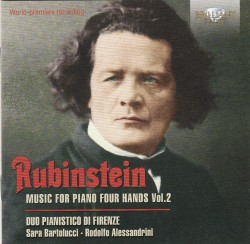
Rubinstein – Music for Piano Four Hands Vol.2
Duo Pianistico di Firenze
Brilliant Classics 95965 (naxosdirect.com)
Pianists Sara Bartolucci and Rodolfo Alessandrini, collectively known as Duo Pianistico di Firenze (Piano Duo of Florence) have been garnering the accolades of the classical world since 1990, mining the overlooked, rarely performed or forgotten piano repertoire of the Western art music canon on a series of recordings, concerts and artistic residencies. Here, on this sprawling 2019 double CD released on the Brilliant Classics label, the Italian duo mightily dig in to the little-known, four-hand piano work of Russian composer Anton Rubinstein (1829–1894).
A touring piano soloist, composer and educator (he is perhaps best known as the teacher of Tchaikovsky), Rubinstein’s work here, similar to some of the best-known pieces of JS Bach, is didactically pedagogical by design. As founder of the Saint Petersburg Conservatory, Rubinstein’s 20-movement long Bal Costumé is not a high-water mark of Russian pianistic virtuosity (for which Rubinstein was known), but rather is intentionally welcoming and accessible to amateur and student pianists, a collection of tuneful miniatures meant for parlour performances for attendees at a costume ball. Although Rubinstein the pianist would become celebrated for his virtuoso performances, he too included Bal costumé in his concerts, performing with Anna Yesipova or Monika Terminskaya, garnering accolades for the popular Toréador et Andalouse, movement seven from this suite. Captured here as the complete suite, this recommended CD set features the beautiful four-hand touch, playing and simpatico interaction of Bartolucci and Alessandrini seamlessly weaving together a unified tapestry of sound that is worth adding to one’s classical CD collection.
Andrew Scott
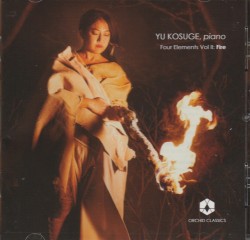
Four Elements Vol.2 Fire
Yu Kosuge
Orchid Classics ORC 100108 (orchidclassics.com)
This disc is Volume 2 of Yu Kosuge’s four-CD series Journey of the Four Elements. Fire begins intimately and after the pianist’s long, well-chosen program of late 19th-/early 20th-century compositions closes with grandeur. In Tchaikovsky’s January: At the Fireside, she conveys a family event’s togetherness well, along with imagined romantic passions. By contrast, five pieces from Max Reger’s Dreams at the Fireside evoke solitude. Here the composer remembers piano works from his youth: for example, piece No.2 references Brahms’ well-known Intermezzo No. 2, Op.118 in A Major. Reger adds complex harmony and voice-leading, but fortunately Kosuge clarifies the tonal structure well. Next, a storm arrives in the guise of Liszt’s symphonic poem Prometheus (arr. Ludwig Stark). Sizzling “lightning flashes,” a difficult fugue and bravura alternating octaves followed by cascading chords, present technical challenges that Kosuge masters ably.
Among succeeding short pieces, Debussy’s brief Les soirs illuminés par l’ardeur du charbon (1917) is a welcome, evocative novelty discovered only in 2001; while the Feux d’artifice (Preludes, Book II) ranks with the best recordings I have heard. Kosuge’s touch is even and crisp, her grasp of the fitful harmonic base secure. The disc’s pièce de résistance is five numbers from Stravinsky’s piano version of his great Firebird Suite (1919). Brilliant handling of the Infernal Dance’s syncopations and cross-rhythms, a mysterious mood with magical tremolos in the Lullaby and astonishing bell-like sonorities at the finale’s tremendous climax cap this marvellous CD.
Roger Knox
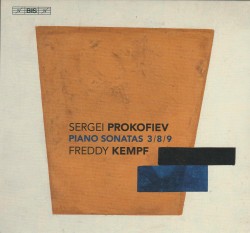
Sergei Prokofiev – Piano Sonatas 3; 8; 9
Freddy Kempf
BIS BIS-2390 SACD (bis.se)
Sergei Prokofiev’s music is a study in dramatic contrasts, not the least because the composer always seemed to look forward while harking back to the past. He was a brilliant piano virtuoso whose work was redolent of melodicism wedded to a tonality that was characterized by cascading warmth often spiked by the force of dramatic rhythms and broad dissonances. All of this is heard in these Piano Sonatas especially the last two – No. 8 and No. 9.
Prokofiev’s work always demanded fingers of flexible steel and those on Freddy Kempf’s hands seem to embody this to perfection. From the first dramatic rendering of the Piano Sonata No. 3 in A Minor Kempf plays like a man possessed, and his breathtaking variety of touch means that the less hard-driven passages of No.8 and No.9 have an unparalleled degree of subtlety and nuance. His muscular style is eminently suited to such tempestuous music.
The Piano Sonata No.3 in A Minor is the shortest and from Prokofiev’s earlier attempts at the form, while No.8 in B-flat Major and No.9 in C Major are much longer and infinitely more intricate. Yet all three live and breathe in sharply characterized music that demands a sense of structure and momentum. Kempf embraces their wide tonal range, sharply drawn contrasts and intricate detail with sublime energy and a wonderful sense of occasion.
Raul da Gama
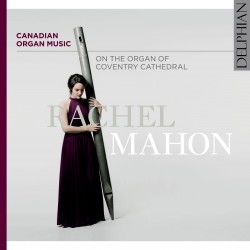
Canadian Organ Music on the Organ of Coventry Cathedral
Rachel Mahon
Delphian Records Ltd. DCD34234 (delphianrecords.co.uk)
On the surface, this disc appears to be an interesting international essay: Canadian organ music played on an English cathedral organ, performed by a Canadian organist working in the UK. It seems straightforward enough but, if one looks into the historical relationship between Canada and Coventry, a much deeper and meaningful relationship is quickly uncovered. In 1940 the Coventry organ was destroyed by German air bombers, reducing the entire medieval building to a pile of rubble. At the same time, the (Royal) Canadian College of Organists was collecting donations from its members to assist with the rebuilding of damaged English instruments. In the end, the decision was made to dedicate the entire amount of raised funds to Coventry, paying for a major part of their new instrument. It is therefore no surprise that there is a large brass maple leaf on the west-end floor of the Cathedral, commemorating Canada’s generosity.
It is with this historical backdrop in mind that organist Rachel Mahon selected her program. The first work, Healey Willan’s monumental Introduction, Passacaglia and Fugue bridges both countries; born in England, Willan later moved to Canada and eventually became known as the “Dean of Canadian composers.” Mahon treats this tripartite tome with the focus it requires, blending rhapsodic virtuosity with careful attention towards the structure of the composition. Gerald Bales’ Petite Suite and Ruth Watson Henderson’s Chromatic Partita are smaller pieces, but no less satisfying to hear on this magnificent organ, while Rachel Laurin’s Symphony No.1 is simply breathtaking in its immensity and dramatic content.
This disc merits repeated listening for numerous reasons, both historical and immediately practical. Mahon, recently appointed the next director of music at Coventry, is a superb performer with a keen ability to craft a satisfying program, and her debut recording is highly recommended.
Matthew Whitfield
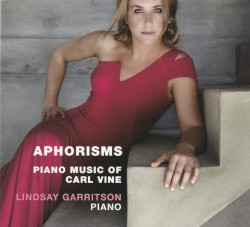
Aphorisms – Piano Music of Carl Vine
Lindsay Garritson
Independent (lindsaygarritson.com)
The music of composer, pianist and conductor Carl Vine so often evokes the lucidity and sun of this artist’s home country: Australia. The world premiere recording of his Fourth Piano Sonata (2019) is included on a new disc by American pianist, Lindsay Garritson, a disc entirely devoted to Vine’s varied piano catalogue. Pianists tend to revel in performing Vine’s music; it is idiomatic and expressive – Romantic at heart yet fresh and buoyant, unmistakably of our time. (American composer Lowell Liebermann’s aesthetic seems a close relative to Vine’s.)
Garritson throws herself headlong into the fulsome soundscape of Vine’s newest piano sonata, in a whorl of an opener to the record, demanding the listener’s attention. Her heart is clearly devoted to every single note of this album, with a seemingly special affection for The Anne Landa Preludes (2006). These programmatic, deeply expressive pieces are aptly suited to Garritson’s musical sensibility as she relishes their expansive resonating lines and tolling chords, born of a personal mode of expression. After these (12) preludes, the record returns to sonata form, in a rhapsodic performance of one of Vine’s most popular works from his early period, the Piano Sonata No.1 of 1990.
After five Bagatelles, including the haunting Threnody (for all of the innocent victims), Garritson treats the listener to Vine’s Toccatissimo (2011), a robust and thrilling finale to this attractive new album by a self-assured young pianist, with a career on the rise.
Adam Sherkin



